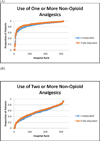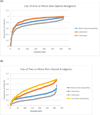Variations in the Use of Perioperative Multimodal Analgesic Therapy
- PMID: 26835644
- PMCID: PMC4792695
- DOI: 10.1097/ALN.0000000000001034
Variations in the Use of Perioperative Multimodal Analgesic Therapy
Abstract
Background: Practice guidelines for perioperative pain management recommend that multimodal analgesic therapy should be used for all postsurgical patients. However, the proportion of patients who actually receive this evidence-based approach is unknown. The objective of this study was to describe hospital-level patterns in the utilization of perioperative multimodal analgesia.
Methods: Data for the study were obtained from the Premier Research Database. Patients undergoing below-knee amputation, open lobectomy, total knee arthroplasty, and open colectomy between 2007 and 2014 were included in the analysis. Patients were considered to have multimodal therapy if they received one or more nonopioid analgesic therapies. Mixed-effects logistic regression models were used to estimate the hospital-specific frequency of multimodal therapy use while adjusting for the case mix of patients and hospital characteristics and accounting for random variation.
Results: The cohort consisted of 799,449 patients who underwent a procedure at 1 of 315 hospitals. The mean probability of receiving multimodal therapy was 90.4%, with 95% of the hospitals having a predicted probability between 42.6 and 99.2%. A secondary analysis examined whether patients received two or more nonopioid analgesics, which gave an average predicted probability of 54.2%, with 95% of the hospitals having a predicted probability between 9.3 and 93.2%.
Conclusions: In this large nationwide sample of surgical admissions in the United States, the authors observed tremendous variation in the utilization of multimodal therapy not accounted for by patient or hospital characteristics. Efforts should be made to identify why there are variations in the use of multimodal analgesic therapy and to promote its adoption in appropriate patients.
Conflict of interest statement
Conflicts of Interest: The authors declare no conflicts of interest.
Figures



References
-
- Strassels SA, Chen C, Carr DB. Postoperative Analgesia: Economics, Resource Use, and Patient Satisfaction in an Urban Teaching Hospital. Anesth. Analg. 2002;94:130–137. - PubMed
-
- Morrison RS, Magaziner J, McLaughlin MA, Orosz G, Silberzweig SB, Koval KJ, Siu AL. The impact of post-operative pain on outcomes following hip fracture. Pain. 2003;103:303–311. - PubMed
-
- Coley KC, Williams BA, DaPos SV, Chen C, Smith RB. Retrospective evaluation of unanticipated admissions and readmissions after same day surgery and associated costs. J Clin Anesth. 2002;14:349–353. - PubMed
-
- Kehlet H, Jensen TS, Woolf CJ. Persistent postsurgical pain: risk factors and prevention. Lancet. 2006;367:1618–1625. - PubMed
-
- Gan TJ, Habib AS, Miller TE, White W, Apfelbaum JL. Incidence, patient satisfaction, and perceptions of post-surgical pain: results from a US national survey. Curr Med Res Opin. 2014;30:149–160. - PubMed
Publication types
MeSH terms
Substances
Grants and funding
LinkOut - more resources
Full Text Sources
Other Literature Sources
Medical

